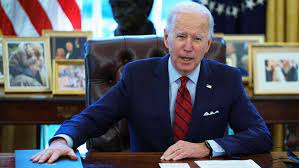
Biden’s Climate Pledge: Not Easy, Not Impossible
Cutting U.S. greenhouse gas emissions in half is doable but hard, experts say, and some of the biggest barriers are political, not technical.
President Joe Biden on Thursday committed the United States to reducing emissions of planet-warming carbon dioxide and other gases by 50% to 52% by 2030 compared with 2005 levels.
Experts and advocates had been calling for a pledge of this size, both to rein in emissions from the world’s largest economy and second-largest polluter and to encourage other countries to step up their efforts.
But to get there, “a lot would have to change very quickly,” said energy expert Philip Rossetti at R Street, a public policy research center.
U.S. emissions are declining, but far too slowly to reach Biden’s target. They would have to fall on a scale that has happened only three times since 2005, Rossetti noted, and not for good reasons — during the COVID-19 pandemic, the 2008-09 financial crisis and during an exceptionally mild winter in 2012.
The Biden administration has proposed broad areas where it sees opportunities for cuts, without giving much detail. It says there are multiple pathways to get there.
But each path faces opposition, experts note. Legislation may struggle to pass in a closely divided Congress. And a conservative Supreme Court may take a dim view of expanding regulations.
Several research groups have mapped out ways that the United States could cut emissions in half.
“We have the policies to do it, and we have the technologies to do it,” said Robbie Orvis, director of energy policy design at Energy Innovation, a policy research group.
For starters, the amount of solar and wind power installed each year needs to be three to four times as much as last year’s record-setting pace.
“It is a big leap to do that, but the technology exists,” Orvis said.
And the technology is cheaper than ever, and getting cheaper.
The cost of wind power has fallen 71% since 2009, according to financial advisory firm Lazard. Solar power is 90% cheaper. Batteries are 80% cheaper than in 2013, according to BloombergNEF.
“We did not predict they would drop this fast 10 years ago,” said Nathan Hultman, director of the University of Maryland Center for Global Sustainability, who helped craft the Obama administration’s climate goals.
In many places, it is now cheaper to build new wind installations than it is to continue running existing coal-fired power plants, the most polluting source of power. Natural gas is cleaner and cheaper than coal, but renewables are now competitive with gas power, too.
Economics alone will not get the United States to a 50% cut by 2030, however. Orvis said the country will reach only 12% under current policies.
Several groups are backing a federal clean electricity standard that would require utilities to produce 80% of their power from renewable sources, nuclear power or fossil fuel plants that capture their carbon dioxide emissions. Twenty-nine states have similar policies.
The next biggest cut would come from transportation, where the largest proportion of U.S. carbon emissions come from. A combination of incentives and regulations would take old, inefficient vehicles off the road and help increase sales of zero-emissions vehicles.
Smaller shares would come from cutting industrial emissions by switching to electrification, where possible, or emerging sources such as hydrogen or ammonia, though these technologies are still in development.
The best path to any of these policies would be through legislation passed by Congress, experts note. Many of them are included in Biden’s $2.3 trillion infrastructure proposal.
But Republicans are firmly opposed to it.
“Their so-called ‘infrastructure’ plan would aim at completely ‘de-carbonizing’ our electric grid, which means hurting our coal and natural gas industries and putting good-paying American jobs into the shredder,” Senate Minority Leader Mitch McConnell said in a statement.
Some policies could be implemented through regulations, which do not require Congress. But it is a riskier approach.
“I’m honestly pretty pessimistic on that because the scope of regulatory authority Biden has is limited,” R Street’s Rossetti said. “The courts are going to challenge any sort of proposal that goes outside of those bounds.”
Plus, regulations can change with administrations, and climate regulations have whiplashed through the past several presidencies. The Trump administration reversed President Barack Obama’s climate regulations, and Biden is reversing Trump’s reversals.
Many of the policies that would get the United States to a 50% cut have strong backing from the private sector.
More than 400 companies signed a letter to Biden ahead of this week’s climate summit asking for a 50% cut. The list includes tech giants Apple and Microsoft, mega-retailers Walmart and Target, automakers Ford and General Motors, and other household names.
The electric utility industry’s main lobby group supports a clean energy standard.
“A well-designed CES makes some sense for us,” Emily Fisher, senior vice president of clean energy at the Edison Electric Institute, told Reuters.
But she cautioned that the industry still needs breakthroughs, in long-term storage and carbon capture, for example, to meet the target.
“We need those technologies, and they don’t exist,” Fisher said.
Getting to 50% “is certainly going to be challenging,” Orvis said, “but I’m cautiously optimistic.”
Read from source:
https://www.voanews.com/science-health/bidens-climate-pledge-not-easy-not-impossible
